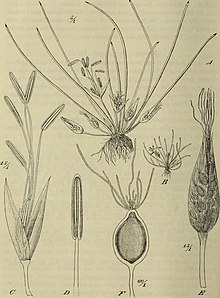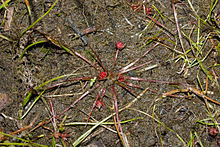히다텔라과
Hydatellaceae| 히다텔라과 | |
|---|---|
 | |
| 1904년 삽화 | |
| 과학적 분류 | |
| 왕국: | 플랜태 |
| Clade: | 기관지 식물 |
| Clade: | 혈관배양액 |
| 주문: | 님파이아레스속 |
| 패밀리: | 히다텔라과 우하만[1][2] |
| 속 | |
히다텔라과는 작은 수생 꽃식물의 과이다.이 과는 호주와 인도에서 자라는 작고 비교적 단순한 식물들로 이루어져 있다.이전에는 풀과 사초목(풀목)과 관련이 있는 것으로 여겨졌지만 DNA와 형태학적 분석의 결과, 그것이 수페를 가진 단일 식물과 밀접한 관계를 가지기 보다는 개화-식물 계통 발생에서 갈라진 최초의 그룹 중 하나를 나타낸다는 것을 보여줌에 따라 다시 목으로 지정되었다.수렴 [3]진화로 인한 유사성입니다.이 과는 트리투리아속만을 포함하고 있으며, 적어도 13종의 종을 가지고 있지만, 이 과의 종 다양성은 [4]상당히 과소평가되고 있을 것이다.
묘사
식물은 물에 잠기고 발아하는 수생식물로, 물 밑의 기질에 뿌리를 두고 있다.그것들은 키가 몇 cm밖에 되지 않는 작은 식물들이다.대부분의 종은 물이 빠지면 봄의 웅덩이에서 꽃을 피우는 일시적인 수생이지만, 몇몇 종은 얕은 호수에서 발견되는 물에 잠긴 여러해살이풀이다.단순한 잎들은 기본적으로 짧은 줄기 주위에 집중되어 있다.개별 종은 동성(여러 종류의 암수동성 질환) 또는 암수동성이고, 풍수분(비호성) 또는 자가수분(자생애)이다.주로 두 개의 약독성 종도 [5]알려져 있다.꽃모양 생식단위는 매우 감소된 개별 꽃을 나타낼 수 있는 미세한 수술 및/또는 암술모양 구조의 작은 집합으로 구성되어 있어 생식단위가 의사일 수 있다.과육이 없는 과일은 모낭이나 아케인이다.[2]
분류법

이 과는 여러 해 동안 풀과 초목의 가까운 친척으로 여겨졌으며, 때로는 푸아레아과(Centrolepidaceae)로 분류되기도 했다.2003년 APG II 시스템은 심지어 최근까지도 물개미목(Hydatellaceae)을 물개미목(Comelinid monocotes)의 풀목(Poales)에 할당했다.그러나, Saarela 등의 DNA 배열과 형태학에 근거한 연구는 히다텔라과가 수련(Nymphaeaceae와 Cabombaceae)의 살아있는 자매군이며, 따라서 가장 오래된 현화 [6]식물의 계통 중 하나임을 보여준다.초기 분류의 개발자들은 이 식물들의 명백히 감소된 식물과 생식 형태학에 현혹되었다.수초로서, 히다텔라과는 환경적 적응을 통해 더 먼 분류군과 형태학적 유사성을 만드는 파생된 특성을 가지고 있다.그들의 형태학적 특성에 대한 신중한 재분석과 소위 '기저' 혈관조식물과의 비교는 이러한 "극적 분류학적 조정"[7][8]을 뒷받침했다.APG III 분류 체계와 APG [1][9]IV 분류 체계에서 이러한 재배치가 인정되고 있다.
현재는 트리투리아속만을 포함하고 있으며, 2008년에 히다텔라속(Hydatella)[10]으로 재정의되었다.
레퍼런스
- ^ a b Angiosperm Phylogeny Group (2009). "An update of the Angiosperm Phylogeny Group classification for the orders and families of flowering plants: APG III". Botanical Journal of the Linnean Society. 161 (2): 105–121. doi:10.1111/j.1095-8339.2009.00996.x. Archived from the original (PDF) on 25 May 2017. Retrieved 26 June 2013.
- ^ a b Macfarlane, T.D.; Watson, L. & Marchant, N.G., eds. (2000). "Hydatellaceae U Hamann". FloraBase: Flora of Western Australian. Retrieved 15 November 2013.
- ^ Givnish, Thomas J.; Zuluaga, Alejandro; Spalink, Daniel; Soto Gomez, Marybel; Lam, Vivienne K. Y.; Saarela, Jeffrey M.; Sass, Chodon; Iles, William J. D.; de Sousa, Danilo José Lima; Leebens-Mack, James; Chris Pires, J.; Zomlefer, Wendy B.; Gandolfo, Maria A.; Davis, Jerrold I.; Stevenson, Dennis W.; dePamphilis, Claude; Specht, Chelsea D.; Graham, Sean W.; Barrett, Craig F.; Ané, Cécile (24 October 2018). "Monocot plastid phylogenomics, timeline, net rates of species diversification, the power of multi-gene analyses, and a functional model for the origin of monocots". American Journal of Botany. Wiley. 105 (11): 1888–1910. doi:10.1002/ajb2.1178. ISSN 0002-9122. PMID 30368769.
- ^ Sokoloff, Dmitry D.; Marques, Isabel; Macfarlane, Terry D.; Remizowa, Margarita V.; Lam, Vivienne K.Y.; Pellicer, Jaume; Hidalgo, Oriane; Rudall, Paula J.; Graham, Sean W. (14 April 2019). "Cryptic species in an ancient flowering‐plant lineage (Hydatellaceae, Nymphaeales) revealed by molecular and micromorphological data". Taxon. Wiley. 68: 1–19. doi:10.1002/tax.12026. ISSN 0040-0262.
- ^ Smissen, Rob D.; Ford, Kerry A.; Champion, Paul D.; Heenan, Peter B. (2019). "Genetic variation in Trithuria inconspicua and T. filamentosa (Hydatellaceae): a new subspecies and a hypothesis of apomixis arising within a predominantly selfing lineage". Australian Systematic Botany. CSIRO Publishing. doi:10.1071/sb18013. ISSN 1030-1887.
- ^ Saarela, Jeffery M.; Rai, Hardeep S.; Doyle, James A.; Endress, Peter K.; Mathews, Sarah; Marchant, Adam D.; Briggs, Barbara G. & Graham, Sean W. (2007). "Hydatellaceae identified as a new branch near the base of the angiosperm phylogenetic tree". Nature. 446 (7133): 312–315. Bibcode:2007Natur.446..312S. doi:10.1038/nature05612. PMID 17361182.
- ^ Rudall, Paula J.; Sokoloff, Dmitry D.; Remizowa, Margarita V.; Conran, John G.; Davis, Jerrold I.; Macfarlane, Terry D. & Stevenson, Dennis W. (2007). "Morphology of Hydatellaceae, an anomalous aquatic family recently recognized as an early-divergent angiosperm lineage". American Journal of Botany. 94 (7): 1073–1092. doi:10.3732/ajb.94.7.1073. hdl:2440/44423. PMID 21636477.
- ^ Friis, Else Marie; Crane, Peter R. & Pederses, Kaj Raunsgaard (2011). Early Flowers and Angiosperm Evolution. Cambridge University Press. ISBN 978-1-139-12392-1.
- ^ Angiosperm Phylogeny Group (2016). "An update of the Angiosperm Phylogeny Group classification for the orders and families of flowering plants: APG IV". Botanical Journal of the Linnean Society. 181 (1): 1–20. doi:10.1111/boj.12385. ISSN 0024-4074.
- ^ Sokoloff, Dmitry D.; Remizowa, Terry D. Macfarlane, Paula J. Rudall, Margarita V.; Macfarlane, Terry D. & Rudall, Paula J. (2008). "Classification of the early-divergent angiosperm family Hydatellaceae: one genus instead of two, four new species and sexual dimorphism in dioecious taxa". Taxon. 57: 179–200.
{{cite journal}}: CS1 maint: 여러 이름: 작성자 목록(링크)
외부 링크
- L. 왓슨과 M.J. Dallwitz(1992년 이후).꽃이 피는 식물의 과: 설명, 일러스트, 식별, 정보 검색.버전: 2006년4월 27일https://web.archive.org/web/20060424062016/http://delta-intkey.com/
- 히다텔라과 사진
- 오스트레일리아 서부의 히다텔라
- 오스트레일리아 서부의 트리투리아
- NCBI 택사노미 브라우저
- CSDL 링크
- 패밀리를 인정한 원본 용지[영구 데드링크]
 위키종의 히다텔라과 관련 자료
위키종의 히다텔라과 관련 자료